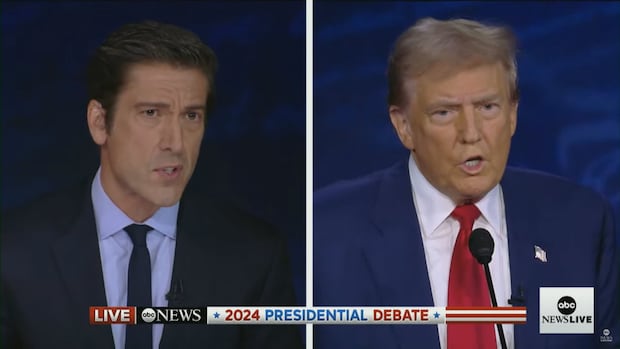
One week after the U.S. Department of Justice dropped an indictment on two Russian propagandists accused of coordinating a disinformation campaign aimed at exacerbating racial tensions in the United States, one particularly bizarre meme associated with that effort appeared to trip up its intended beneficiary at a critical moment.
“In Springfield, they’re eating the dogs,” Donald Trump announced during his debate with Democratic presidential candidate Kamala Harris on Tuesday night. “The people that came in. They’re eating the cats. They’re eating — they’re eating the pets of the people that live there.”
Trump was widely ridiculed for repeating the claim — already debunked by the city manager and police in Springfield, Ohio, and by the state’s Republican governor — that Haitian immigrants have been hunting and eating pet cats and wild ducks and geese (Trump appears to have thrown dogs into the mix on his own initiative).
After Republican presidential candidate Donald Trump claimed that illegal immigrants were eating dogs and cats in Springfield, Ohio, ABC News Presidential Debate moderator David Muir said the city manager told ABC News ‘there have been no credible reports’ of such incidents.
But Trump — who continued to post about cats on his Truth Social account following the debate — had reason to believe the claim might work for him. After all, his party had spent the previous 36 hours pumping the story through its social media channels, complete with a torrent of AI-generated memes showing Donald Trump saving cats from black Haitians.
Individual senators and congressmen jumped on the save-the-cats bandwagon. A tweet by the House Judiciary GOP garnered over 70 million views.
Protect America’s pets! <a href=”https://t.co/ktK5hDoxFo”>https://t.co/ktK5hDoxFo</a>
—@RepAndyBiggsAZ
We may never know exactly how the false story first began to circulate. A white supremacist account on X tweeted a police video labelled “Black woman eats the neighbor’s cat” on Saturday morning — she was not Haitian and the events took place in Canton, Ohio, not Springfield.
By that evening, the story had come to the attention of Malaysia-based RT (formerly Russia Today) columnist and online influencer Ian Miles Cheong, whose work appears in Canadian outlets such as Rebel News and the Post Millennial.
Cheong soon connected cat-eating to a different Ohio town that has experienced an influx of Haitian migrants, and the story was off to the races, with an assist from other channels of amplification strongly associated with Russia.
From memes to billboards and back
It was quickly echoed, with AI-generated memes, by Benny Johnson, one of the right-wing commenters employed by Tenet Media, which was paid large amounts of Russian money through Canadian influencer Lauren Chen.
Soon, Elon Musk — a superspreader of Russian propaganda themes — was fully on board with numerous tweets and retweets over a 48-hour period.
Republican vice-presidential candidate J.D. Vance warned that “reports now show that people have had their pets abducted and eaten by people who shouldn’t be in this country. Where is our border czar?”

The story performed a full circle through the pro-Trump ecosystem, leaping from the accounts of Russian-affiliated influencers to mainstream Republican accounts, then from the online world to the real world as an official GOP billboard campaign. Johnson and Cheong both tweeted about the billboards.
Small wonder, then, that an apparently confused Trump would cite the story during Tuesday’s debate.
Why white resentment works for the Kremlin
The glee with which influencers pounced on the kitten story highlights a curious feature of Russian propaganda and disinformation: its fascination with race and immigration.
It’s obvious why Russia would want to spread negative stories about Ukraine, or positive stories about Putin. It’s less obvious why it would want to spread stories about Haitian migrants hunting cats.
But race and immigration are constant themes running through the background documents gathered during the FBI’s investigation of Russian state broadcaster RT’s alleged scheme to pay an American firm $10 million to, in the words of the U.S. Department of Justice, “create and distribute content to U.S. audiences with hidden Russian government messaging.”

Those Russian documents allegedly were written by Ilya Gambashidze, founder of the Social Design Agency, which produced much of the content for Russian influence operations in the U.S. and around the world.
“It is important that Democrats are also people of color and supporters of ‘affirmative action’ and ‘reverse discrimination,’ i.e. infringement on the rights of the white population of the United States, while Republicans are the victims of discrimination by people of color,” writes Gambashidze in one of those documents outlining an influence operation.
“This is at the time when the United States is suffering from rising prices, primarily for gasoline, historically high inflation and the actual impoverishment of white taxpayers, a significant part of the middle class. Under these circumstances, the recipients of public assistance, unemployed people of color and residents of large cities end up being privileged groups of the population.
“It is these sentiments that should be exploited in the course of an information campaign in the United States.”
Gambashidze adds that the targets of the campaign should be “Republican voters, Trump supporters, supporters of traditional family values, white Americans representing the lower and lower-middle class.”
‘The mainstream media will never tell you this’
Russia expert Robert David English of the University of Southern California-Annenberg said that, on the simplest level, Russian propaganda’s focus on economically-stressed white voters simply reflects its number-one priority in the U.S., which was expressed over and over in the FBI documents: securing the re-election of Donald Trump.
“Working class, non-college-educated whites — and mainly white men — are the Republican Party base right now. They are the MAGA voters,” said English. “But there are presumably lots who are one foot in that camp, they’re still independents who aren’t committed to Donald Trump but share many of those concerns.
“So fanning those flames and harping on those issues, the calculation is, will help push them into the Donald Trump camp, which includes foreign policy decisions and directions like terminating funding for Ukraine that do serve Russia’s interest.”
The Russian documents explain how online influencers and commenters can channel anger about migrants into anger against Ukraine, or resistance to assisting Ukraine.
“Their main message in these campaigns is simply, ‘Focus on your internal issues. Do not help other countries,'” said Roman Osadchuk of the Atlantic Council’s Digital Forensic Research Lab in Washington.
In one “sample for dissemination” included in a written pitch for an influence operation called ‘Project Good Old USA ,’ Gambashidze suggests a message influencers could use to praise an individual U.S. congressman for voting against sending aid to Ukraine: “An endangered breed of politician — for some reason he tells the truth and operates with a kind of strange concept: Homeland.”
He also suggests contrasting the congressman’s actions with those of President Joe Biden by comparing his adminstration’s aid for Ukraine with the sums it spends on securing the southern border. Again, Gambashidze is ready with a canned phrase for influencers: “Apparently, Ukraine is more than twice as important to [Biden] as our homeland.”
And Gambashidze adds a rider that serves as a key to all Russian disinformation: “You should continuously repeat that this is what is really happening, but the mainstream media will never tell you about it.”
Race-baiting for clicks
In the documents released by the FBI, Gambashidze also discusses exploiting the problem of inflation for propaganda purposes.
But race and migration offer benefits to Russian influencers that the cost of living does not, said Osadchuk.
Race “is an easy engagement generator,” he said. “Social media algorithms prefer news and content that fuels rage and discussion. This is the topic that will likely bring more people, or make some people really irritated with others.”
The more comments and reaction a message generates, the more the algorithms circulate that message far and wide.
But race is also an inherently divisive issue, said Osadchuk, and division —”making people see less of a co-citizen and more of an enemy” — is Russia’s goal.
“They are trying to create an idea that half of your country is your enemy.”
The U.S. also offers an easy target, said Osadchuk.
“Race is always a problematic issue for the United States, historically speaking,” he said. “That’s why for Russian propaganda, it’s just low-hanging fruit. Regardless of where you’re putting the pressure, it’s going to be painful.”
Osadchuk said it’s important to remember that while Russia is more obviously pushing the buttons of white rage in the U.S., it has always sought to play both sides.
In 1984, seeking to retaliate for the West’s boycott of the 1980 Moscow Olympics, the Soviet KGB sought to disrupt the 1984 games in Los Angeles through disinformation.
“Athletes from Africa received leaflets claiming that the local branches of KKK would be persecuting them on the street … basically framing the United States as hostile towards the African countries and people of colour,” said Osadchuk.
‘Mexico doesn’t forgive’
That tradition continues today. Even as Russian propagandists stoke American fears of migrants coming across the U.S.-Mexico border, they’re also trying to stoke Mexican resentment of the U.S.
The FBI documents include a proposal for a Russian influence campaign aimed at getting Mexicans angry about the loss of half their country to the U.S. in the 1846 U.S.-Mexican War, under the slogan “Mexico no perdona,” or “Mexico doesn’t forgive.”
“Let’s imagine a map of the United States depicted as broken glass,” says the project proposal. “A sign ‘Mexico no perdona’ will be displayed along the division line. At first glance, such slogan could be used by some fringe political organization, the ultra-right or the ultra-left.”
“Trump,” the document adds, “is so much in need of an exacerbated confrontation with Mexico.”

The project proposal laments the fact that the U.S. economy “is very healthy” (the Russian view, expressed in the FBI documents, is that American voters actually have little to complain about economically) and points out that “the United States simply does not have threats and does not spend energy on mitigating them …
“In order to somehow spur the society when the economy is obviously booming, it is necessary to create a perceivable threat.”
That’s where the project proposal sees a need for some angry Mexicans — “to show the world that a huge country with a population of 130 million … has finally woken up.
“Today, the time has come to show the United States that it is under threat, and we can do it.”
Meanwhile, the memes about imaginary pet-eating migrants continue to circulate online.
Even with the story thoroughly debunked, Cheong continues to tweet out new AI-generated videos about Haitians eating puppies and kittens.
On Wednesday, Vance encouraged people to “keep the cat memes flowing,” even as he acknowledged that “it’s possible, of course, that all of these rumors will turn out to have been false.”
Spreaders of disinformation know that repetition can make a lie seem true, or at least raise doubts. And repetition normalizes even the most ludicrous claims. Even people who don’t believe Haitians are eating pets will, over time, become less outraged that such a claim is being made. That will open the door to the next, even wilder claim.
In short, don’t expect the cats and ducks to disappear anytime soon.
